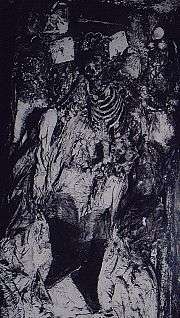Dingling (Ming)
| Dingling Mausoleum of emperor Wanli | |
|---|---|
| 明定陵 | |
 | |
| General information | |
| Location | Changping District, Peking |
| Country | China |
| Coordinates | 40°17′40″N 116°13′0″E / 40.29444°N 116.21667°ECoordinates: 40°17′40″N 116°13′0″E / 40.29444°N 116.21667°E |
Dingling (明定陵; Míngdìnglíng) is a mausoleum in China where emperor Wanli, together with his two empresses Wang Xijie and Dowager Xiaojing, was buried. Dingling is one of the thirteen imperial tombs at Ming tombs in Changping district 45 km north of central Beijing. Dingling is the only tomb of a Ming dynasty emperor that has been opened.
Emperor Wanli was the thirteenth emperor of the Ming dynasty and ruled from 1572 to 1620. His mausoleum Dingling was built from 1584 until 1590 and occupies a surface area of 180 000 square meters. The one who first suggested that the grave should be excavated was the historian and Peking deputy mayor Wu Han. The excavation started in May 1959 and was completed within a year. More than 3 000 artefacts were found in the 1 195 square meter underground palace. The Underground palace consists of five halls with some walls, and is located 27 meter below ground surface. In 1959 the Dingling museum was opened to the public.[1][2]

The excavation of Dingling has been questioned because the excavation was never formally approved and because the excavation report is blamed to be inadequate. Worse was the lack of technology to preserve the excavated bodies, which were quickly destroyed after the tomb opened. Even the coffins were destroyed and the buried remains thrown away. The imperial skeleton was burned 1966 during the first phase of the Cultural Revolution. The failure of the excavation of Dingling has been used as an argument against the opening of the Tang dynasty Qianling Mausoleum and the Mausoleum of the First Qin Emperor.[4]
The name Dingling has been used for Chinese imperial tombs both before and after the Ming dynasty. The Tang dynasty emperor Zhongzong (dead 710) is buried in Dingling north of Xi'an and Qing dynasty emperor Xianfeng (dead 1861) is buried in Dingling in the Eastern Qing tombs east of Beijing.
References
Notes
- ↑ Editors of Reader's Digest, . (2008). Atlas of World Heritage: China. Readers Digest. p. 177.
- ↑ "Dingling Tomb". Beijing Ming Tombs Office of the Special Administrative Region. Retrieved 24 June 2017.
- ↑ "China's reluctant Emperor", The New York Times, Sheila Melvin, Sept. 7, 2011.
- ↑ "To Dig or Not to Dig: Qianling Mausoleum in the Spotlight Again". China Heritage Quarterly. Retrieved 24 June 2017.
Printed References
- Editors of Reader's Digest, . (2008). Atlas of World Heritage: China. Readers Digest.